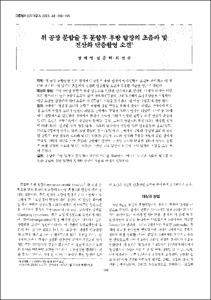위 공장 문합술 후 문합부 후방 탈장의 초음파 및 전산화 단층촬영 소견
- Keimyung Author(s)
- Kwon, Jung Hyeok; Choi, Jin Soo
- Department
- Dept. of Radiology (영상의학)
- Journal Title
- 대한방사선의학회지
- Issued Date
- 2003
- Volume
- 49
- Issue
- 3
- Abstract
- Purpose: To review the radiologic findings of retroanastomotic hernia and to derive useful US and CT criteria to assist in the diagnosis of the condition in patients who have undergone gastrojejunostomy. Materials and Methods: During a recent eight-year period, we encountered 11 consecutive cases of retroanastomotic hernia. Of the patients involved, nine underwent ultrasound (US), eight underwent computed tomography (CT), and in three, small bowel follow-through imaging was performed. The US and CT scans were reviewed to determine abnormal findings; surgical proof was available in all cases. Results: The efferent loop was herniated through the defect created behind the anastomosis in eight cases, both the efferent and afferent loop in two cases, and the afferent loop in one case. Retroanastomotic hernia was prospectively diagnosed in ten of these eleven cases. Among the eight cases of efferent loop herniation, US and CT signs of retroanastomotic hernia included whirling of mesenteric vessels, jejunal loops and mesentery in the periumbilical abdomen (8/8); mural thickening of herniated bowel loops (6/8); dilatation of herniated bowel loops (4/8); (at US) decreased peristalsis of herniated bowel loops (3/7); and (at CT) decreased contrast enhancement of herniated bowel loops (1/5). In one case, US and CT signs of retroanastomotic hernia of the afferent loop included its dilatation and whirling of a short length behind the anastomosis. In two cases, US and CT signs of retroanastomotic hernia of both the afferent and efferent loop included findings of both afferent and efferent loop herniation. Conclusion: Retroanastomotic hernia is an important and underdiagnosed condition, and the US and CT findings we have described may permit its accurate diagnosis.
목적 : 위 공장 문합술을 받은 환자에서 문합부 후방 탈장의 방사선학적 소견을 분석하고 이 질환을 진단하는데 있어서 초음파와 전산화 단층촬영 소견의 유용한 기준을 얻고자 하였다.
대상과 방법 : 지난 8년간 문합부 후방 탈장으로 진단된 연속적으로 발생한 11명의 환자를 대상으로 했으며, 이 들은 9예의 초음파 검사, 8예의 CT검사, 그리고 3예의 소장조영술을 시행했다. 이상 소견을 결정하기 위해 초음파 및 CT검사 소견을 분석했다. 전 예를 수술로 확진을 했다.
결과 : 8예에서 원심성 고리가 문합부 후방에 생긴 구멍을 통해서 탈장이 되었고, 2예에서 원심성 고리와 구심성 고리가 탈장이 되었고, 1예에서 구심성 고리가 탈장이 되었다. 11예 중 10예에서 전향적으로 진단했다. 8예에서 존재한 원심성 고리가 탈장된 문합부 후방 탈장의 초음파 및 CT 소견은 배꼽주위에서 상장간막 혈관들, 공장, 그리고 장간막의 회전(8/8), 탈장된 장의 벽 비후(6/8), 탈장된 장의 조영 증강의 감소(1/5)였다. 1예에서 경험한 구심성 고리가 탈장된 문합부 후방 탈장의 초음파 및 CT 소견은 구심성 고리의 팽창과 문합부 후방에 짧은 길이의 구심성 고리의 회전을 보여 주었다. 2예에서 경험한 구심성 고리와 원심성 고리가 탈장된 문합부 후방 탈장의 초음파 및 CT 소견은 구심성 고리의 팽창과 문합부 후방에 짧은 길이의 구심성 고리의 회전을 보여주었다. 2에에서 경험한 구심성 고리와 원심성 고리가 탈장된 문합부 후방 탈장의 초음파 및 CT 소견은 구심성 고리 탈장과 원심성 고리 탈장의 소견을 모두 보여 주었다.
결론 : 문합부 후방 탈장은 중요하다 진단이 어려운 질환이다. 여기서 보고된 초음파 및 CT 소견은 문합부 후방 탈장의 정확한 진단에 도움을 주리라 생각한다.
- Alternative Title
- US and CT Findings of Retroanastomotic Hernia after Gastrojejunostomy.
- Publisher
- School of Medicine
- Citation
- 장희영 et al. (2003). 위 공장 문합술 후 문합부 후방 탈장의 초음파 및 전산화 단층촬영 소견. 대한방사선의학회지, 49(3), 189–195.
- Type
- Article
- ISSN
- 0301-2867
- Appears in Collections:
- 1. School of Medicine (의과대학) > Dept. of Radiology (영상의학)
- 파일 목록
-
-
Download
 oak-bbb-1016.pdf
기타 데이터 / 1.4 MB / Adobe PDF
oak-bbb-1016.pdf
기타 데이터 / 1.4 MB / Adobe PDF
-
Items in Repository are protected by copyright, with all rights reserved, unless otherwise indicated.